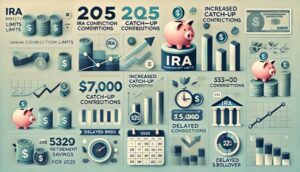The Roth IRA (Individual Retirement Account) is one of the most powerful investment accounts you can have to help maximize your retirement savings with its unique tax advantages and flexibility. Despite its considerable benefits, it remains underutilized by many who could benefit from its features. Here is a quick breakdown of the rules around the Roth IRA and how it can benefit your portfolio.
1. Tax Treatment: Roth IRAs offer tax-free growth and tax-free withdrawals in retirement, provided certain conditions are met. Contributions are made with after-tax dollars, so there are no immediate tax benefits, but qualified withdrawals, including earnings, are tax-free.
2. Contribution Limits: As of 2024, the annual contribution limit for Roth IRAs is $7,000 for individuals under 50, with an additional $1,000 catch-up contribution for those 50 and older. These limits can change over time due to inflation adjustments.
3. Income Limits: There are income limits for contributing directly to a Roth IRA. In 2024, for single filers, the ability to contribute to a Roth IRA begins to phase out at $146,000 and is completely phased out at $161,000. For married couples filing jointly, the phase-out range starts at $230,000 and ends at $240,000.
4. Age Requirements: Unlike traditional IRAs, Roth IRAs have no age limit for making contributions. As long as you have earned income, you can continue contributing to a Roth IRA, even after reaching age 70½.
5. Withdrawal Rules: Contributions to a Roth IRA can be withdrawn at any time without penalty or tax, as they have already been taxed. However, earnings withdrawn before age 59½ may be subject to both income tax and a 10% penalty, unless certain exceptions apply.
6. No Required Minimum Distributions (RMDs): Unlike traditional IRAs, Roth IRAs do not require you to take RMDs during your lifetime. This provides flexibility in managing retirement income and allows funds to continue growing tax-free for as long as you wish.
7. Investment Options: Roth IRAs offer a wide range of investment options, including stocks, bonds, mutual funds, ETFs, and more. You can tailor your investment strategy to your risk tolerance, time horizon, and financial goals.
8. Estate Planning Benefits: Roth IRAs can be valuable estate planning tools because they do not require RMDs during the owner’s lifetime. This means you can potentially pass on a tax-free inheritance to your heirs.
9. Conversion Options: If you have a traditional IRA or an eligible employer-sponsored retirement plan, you may be able to convert all or part of those funds to a Roth IRA through a Roth conversion. However, you will need to pay income taxes on the amount converted in the year of the conversion.
Here is the link to the IRS on Roth IRAs. Please note that the 2024 limits have not been updated yet.





